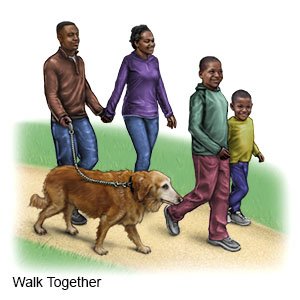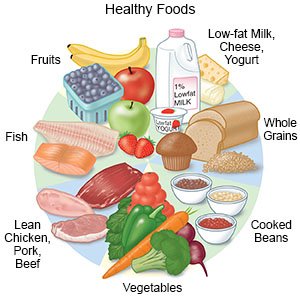Migraine Headache in Children
Medically reviewed by Drugs.com. Last updated on Aug 4, 2025.
What is a migraine headache?
A migraine is a severe headache. They are common in children. The pain can be so severe that it interferes with your child's daily activities. A migraine can last a few hours up to several days. The exact cause of migraines is not known. Migraine headaches often run in families.
What are the warning signs that a migraine headache is about to start?
- Mood changes, irritability, or lack of interest in doing usual activities
- Being more tired than usual or yawning more often
- Food cravings or increased thirst
- Visual changes (often called auras) such as blurred vision, colors, blind spots, or bright spots
- Tingling or numbness in an arm or leg
What signs and symptoms may occur with a migraine headache?
- Pounding, pulsing, or throbbing pain on one or both sides of your child's head
- Nausea, vomiting, or abdominal pain
- Sensitivity to light or noise
- Noise or ringing in your child's ears
- Dizziness or confusion
What can trigger a migraine headache?
- Stress, eye strain, oversleeping, or not getting enough sleep
- Hormone changes during a monthly period or from birth control pills in adolescent girls
- Skipping meals, going too long without eating, or not drinking enough liquids
- Certain foods such as cheese, chocolate, citrus fruits, processed meats, and drinks that contain caffeine
- Foods that contain gluten, nitrates, MSG, or artificial sweeteners
- Direct sunlight, bright or flashing lights, loud noises, smoke, or strong smells
- Heat, humidity, or changes in the weather
How is a migraine headache diagnosed?
Your child's healthcare provider will ask about your child's headaches. Have your child describe the pain and any other symptoms, such as nausea. Tell the provider if you think anything triggers the pain. The provider will also want to know if pain tends to start after your child eats or drinks anything. Tell the provider about any medical conditions your child has or that run in the family. Include any recent stressors that your child has had at home or school. Your child may also need any of the following:
- A neurologic exam may be done. Your child's provider will check how your child's pupils react to light. Your child's memory, hand grasp, and balance may also be tested.
- MRI or CT pictures may be done to find the cause of your child's migraine headache. Your child may be given contrast liquid so his or her brain shows up better in the pictures. Tell the healthcare provider if your child has ever had an allergic reaction to contrast liquid. Do not let your child enter the MRI room with anything metal. Metal can cause serious injury. Tell the healthcare provider if your child has any metal in or on his or her body.
Related medications
How is a migraine headache treated?
Migraines cannot be cured, but symptoms can be relieved. The goal of treatment is to manage your child's symptoms.
- Cognitive behavior therapy (CBT) can help your child learn ways to manage and prevent migraines. A therapist can teach your child to relax and to reduce stress. Your child may learn ways to create healthy nutrition, activity, and sleep habits to prevent migraines. The therapist can also help your child manage conditions that can affect migraines, such as anxiety or depression.
- Medicines may be given to help your child manage migraines. Have your child take the medicine as soon as a migraine begins, or as directed. Healthcare providers can help you decide which medicines are right for your child. Your child may need to try more than one of the following to find what works best for him or her:
- NSAIDs , such as ibuprofen, help decrease swelling, pain, and fever. This medicine is available with or without a doctor's order. NSAIDs can cause stomach bleeding or kidney problems in certain people. If your child takes blood thinner medicine, always ask if NSAIDs are safe for him or her. Always read the medicine label and follow directions. Do not give these medicines to children younger than 6 months without direction from a healthcare provider.
- Acetaminophen decreases pain and fever. It is available without a doctor's order. Ask how much to give your child and how often to give it. Follow directions. Read the labels of all other medicines your child uses to see if they also contain acetaminophen, or ask your child's doctor or pharmacist. Acetaminophen can cause liver damage if not taken correctly.
- Do not give aspirin to children younger than 18 years. Your child could develop Reye syndrome if he or she has the flu or a fever and takes aspirin. Reye syndrome can cause life-threatening brain and liver damage. Check your child's medicine labels for aspirin or salicylates.
- Medicines to help prevent migraine headaches may be given if your child has migraines often.
- Antinausea medicine may be given to calm your child's stomach and to help prevent vomiting. The medicine may also help relieve pain.
Treatment options
The following list of medications are related to or used in the treatment of this condition.
What can I do to manage my child's migraines?
- Have your child rest in a dark, quiet room. This will help decrease the pain. Sleep may also help relieve the pain.
- Apply ice to decrease pain. Use an ice pack, or put crushed ice in a plastic bag. Cover the ice pack with a towel and place it on your child's head. Apply ice for 15 to 20 minutes every hour.
- Apply heat to decrease pain and muscle spasms. Use a small towel dampened with warm water or a heating pad, or have your child sit in a warm bath. Apply heat on the area for 20 to 30 minutes every 2 hours. You may alternate heat and ice.
- Keep a migraine record. Write down when your child's migraines start and stop. Keep track of how often the headaches happen. Ask your child to describe the pain and where it hurts. Write down the number of days that you gave your child pain medicine. If your child has caffeine, write down how often he or she has it. Write down anything else that seems to trigger the headaches. Bring this record with you each time your child sees his or her healthcare provider.
How can I help my child prevent another migraine headache?
- Prevent a medicine overuse headache. Have your child take pain medicines only as long as directed. A medicine may be limited to a certain amount each month. Your child's healthcare provider can help you create a plan so your child gets a safe amount each month.
- Help your child get enough sleep. Your child should get 8 to 10 hours of sleep each night. Help your child create a sleep schedule. Have your child go to bed and wake up at the same times each day. It may be helpful for your child to do something relaxing before bed. Do not let your child watch television right before bed.
- Encourage your child to get be physically active. Regular physical activity may help to prevent a migraine headache and reduce the number of headaches. Most experts recommend 1 hour of physical activity each day. Help your child get at least 30 minutes of physical activity on most days of the week.

- Encourage your child to eat a variety of healthy foods. Have your child eat 3 meals and 1 to 2 snacks each day at regular times. Include healthy foods such as fruit, vegetables, whole-grain breads, low-fat dairy products, beans, lean meat, and fish. Do not let your child have foods or drinks that trigger his or her migraines.

- Encourage your child to drink plenty of liquids. Your child's provider may recommend 8 to 12 cups each day. Make sure these drinks do not contain caffeine. Caffeine can trigger migraines and disrupt your child's sleep pattern.
- Help your child manage stress. Stress can trigger migraine headaches. It may helpful to allow your child time to relax after school each day. Consider decreasing the amount of activities your child is involved in if these activities are causing stress. Talk to your child's provider about other ways to decrease your child's stress.
- Talk to your adolescent about not smoking. Nicotine and other chemicals in cigarettes and cigars can trigger a headache or make it worse. Keep your child away from cigarette smoke. Secondhand smoke can also trigger a migraine headache or make it worse. Ask your adolescent's provider for information if he or she currently smokes and needs help to quit. E-cigarettes or smokeless tobacco still contain nicotine. Talk to your adolescent's provider before he or she uses these products.
Call your local emergency number (911 in the US) or have someone call if:
- Your child has a seizure.
When should I seek immediate care?
- Your child has a severe headache with a fever or a stiff neck.
- Your child has new problems with vision, balance, speech, or movement.
- Your child has weakness in an arm or leg, or he or she cannot move it.
- Your child's vomiting does not stop.
- Your child has migraine pain that is worse than usual.
- Your child's migraine headaches do not improve or get worse, even with pain medicines.
When should I call my child's doctor?
- Your child has headaches more often, or you notice a change in when he or she gets the headaches.
- Your child's migraines occur in the morning with or without vomiting.
- Your child's migraine pain wakes him or her up from sleep.
- Your child's migraine pain gets worse when he or she coughs, urinates, or has a bowel movement.
- Your child has regular migraine pain in the same area.
- You notice a change in your child's personality.
- You have questions or concerns about your child's condition or care.
Care Agreement
You have the right to help plan your child's care. Learn about your child's health condition and how it may be treated. Discuss treatment options with your child's healthcare providers to decide what care you want for your child. The above information is an educational aid only. It is not intended as medical advice for individual conditions or treatments. Talk to your doctor, nurse or pharmacist before following any medical regimen to see if it is safe and effective for you.© Copyright Merative 2025 Information is for End User's use only and may not be sold, redistributed or otherwise used for commercial purposes.
Learn more about Migraine Headache
Treatment options
Care guides
Symptoms and treatments
Medicine.com guides (external)
Further information
Always consult your healthcare provider to ensure the information displayed on this page applies to your personal circumstances.
